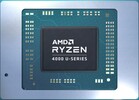AMD Ryzen 7 4980U vs Qualcomm Snapdragon X Plus X1P-64-100
AMD Ryzen 7 4980U
► remove from comparison
The AMD Ryzen 7 4980U is a Renoir family processor designed for certain Microsoft Surface systems. 4980U has eight Zen 2 cores clocked at 2.0 GHz (base clock speed) to 4.4 GHz (Boost) with thread-doubling SMT tech enabled for a total of 16 threads. The chip is manufactured on the modern 7 nm TSMC process and partly thanks to that AMD promises a 2x improvement in performance-per-Watt over Ryzen 3000 series mobile CPUs.
Architecture
The Zen 2 microarchitecture has brought a sizeable per-thread performance boost compared to the outgoing Zen+ parts. Renoir product family is also the first to introduce 8-core ULV processors to laptop market, keeping power consumption within reasonable limits. This AMD processor family is very impressive from most perspectives. One of the disatvantages to keep in mind is the lack of PCI-Express 4 support, meaning these blazing-fast NVMe SSDs will be limited to 3.9 GB/s tops.
Ryzen 7 4980U is designed to work with quad-channel LPDDR4 memory at up to 4,267 MHz. 8 MB of Level 3 are present in this chip. The Ryzen 7 gets soldered straight to the motherboard (FP6 socket) and is thus not user-replaceable. Please go to our Renoir hub page for more information on the product family.
Performance
The 4980U is the fastest U-class Ryzen 4000 series chip. As such, its clock speeds are 200 MHz higher (both the base one and Boost one) than what the Ryzen 7 4800U has.
It is thus hardly surprising that the average 4980U in our database is in the same league as the Ryzen 7 5800U and also the Core i7-1260P, as far as multi-thread benchmark scores are concerned.
Graphics
In addition to its eight CPU cores, the Ryzen 7 also features the Radeon RX Vega 8 graphics adapter with 8 CUs (= 512 shaders) at up to 1,950 MHz. This iGPU is compatible with FreeSync and DirectX 12 and is able to HW-decode AVC, HEVC, VP9-encoded videos (no AV1 support here). Vega 8 is capable of outputting UHD 2160p60 video signal to several monitors and, similar to Intel's Iris Xe (80 EUs), is good enough for a bit of light gaming on the go, provided one is content with sub-1080p resolutions and low/medium quailty presets.
Power consumption
The APU has a default TDP, also known as the long-term power limit, of 15 W; much like it is with other U-class Ryzen 4000 chips, AMD is fine with laptop makers (Microsoft, in this case) changing that value to anything between 10 W and 25 W.
The 7 nm TSMC process this Ryzen 7 is built with makes for above average, as of mid 2022, energy efficiency.
Qualcomm Snapdragon X Plus X1P-64-100
► remove from comparison
The Snapdragon X Plus X1P-64-100 is an ARM architecture processor (SoC) for use in Windows laptops that debuted in April 2024. The X1P-64-100 has 10 Oryon CPU cores (6 P-cores and 4 E-cores) running at no more than 3.4 GHz. Other key features include a 3.8 TFLOPS Adreno GPU, a 45 TOPS Hexagon NPU and an impressively fast LPDDR5x-8448 memory controller.
The chip's smarter X Elite series brothers including first and foremost the Snapdragon X Elite X1E-84-100 use the same die with the same GPU and the same NPU but with more CPU cores, higher clock speeds on CPU cores as well as on the iGPU, and quite possibly higher power targets.
Architecture and Features
Qualcomm Oryon cores are said to be based on the ARM v8.7 microarchitecture. Much like modern AMD and Intel processors, the Snapdragon chip is compatible with USB 4 and thus with Thunderbolt 4; it remains to be seen if the X Plus is compatible with GeForce or Radeon discrete graphics cards.
The Qualcomm SoC is said to have 12 PCIe 4 and 4 PCIe 3 lanes for connecting various kinds of devices. NVMe SSDs are supported with a throughput of up to 7.9 GB/s; furthermore, most laptops built around the chip are expected to have 16 GB of LPDDR5X-8448 RAM. There is also a 45 TOPS NPU for accelerating AI workloads.
Performance
If the official performance data is any indication, the X Plus should be a whole lot slower than the 9-core Apple M4 in multi-thread workloads while being a lot more power-hungry. We'll make sure to update this section once we have in-house testing results.
Like any other Windows on ARM platform, the Snapdragon X chip works best with applications and games compiled specifically for ARM processors, of which there aren't many for the time being.
Graphics
The integrated Adreno GPU is supposed to be DirectX 12-compatible (not DirectX 12 Ultimate-compatible; as the rumors have it, there is no ray tracing of any kind here). It is also supposed to deliver up to 3.8 TFLOPS of performance. For reference, the slowest professional Nvidia Ada Generation graphics card for laptops, the RTX 500 Ada, delivers up to 9.2 TFLOPS.
The Qualcomm iGPU will let you use up to 3 UHD 2160p monitors simultaneously. 2160p120 integrated displays are supported, as are the popular AV1, HEVC and AVC video codecs (both decoding and encoding).
Power consumption
The X1P-64-100 is most likely going to be less power-hungry than its more powerful X Elite brothers. Expect to see anything between 10 W and 35 W under long-term workloads because that's what Ryzen U chips normally consume.
The SoC is built with a 4 nm TSMC process for decent, as of H1 2024, energy efficiency.
| Model | AMD Ryzen 7 4980U | Qualcomm Snapdragon X Plus X1P-64-100 | ||||||||||||||||||||||||||||||||||||||||||||||||
| Series | AMD Renoir (Ryzen 4000 APU) | Qualcomm Snapdragon X | ||||||||||||||||||||||||||||||||||||||||||||||||
| Codename | Renoir-U (Zen 2) | Oryon | ||||||||||||||||||||||||||||||||||||||||||||||||
| Series: Snapdragon X Oryon |
|
| ||||||||||||||||||||||||||||||||||||||||||||||||
| Clock | 2000 - 4400 MHz | <=3400 MHz | ||||||||||||||||||||||||||||||||||||||||||||||||
| L1 Cache | 512 KB | |||||||||||||||||||||||||||||||||||||||||||||||||
| L2 Cache | 4 MB | |||||||||||||||||||||||||||||||||||||||||||||||||
| L3 Cache | 8 MB | |||||||||||||||||||||||||||||||||||||||||||||||||
| Cores / Threads | 8 / 16 | 12 / 12 6 x 3.4 GHz Qualcomm Oryon P-core 4 x 3.4 GHz Qualcomm Oryon E-core | ||||||||||||||||||||||||||||||||||||||||||||||||
| TDP | 15 Watt | |||||||||||||||||||||||||||||||||||||||||||||||||
| Technology | 7 nm | 4 nm | ||||||||||||||||||||||||||||||||||||||||||||||||
| max. Temp. | 105 °C | |||||||||||||||||||||||||||||||||||||||||||||||||
| Socket | FP6 | |||||||||||||||||||||||||||||||||||||||||||||||||
| Features | LPDDR4-4266 RAM, PCIe 3, MMX, SSE, SSE2, SSE3, SSSE3, SSE4A, SSE4.1, SSE4.2, AVX, AVX2, BMI2, ABM, FMA, ADX, SMEP, SMAP, SMT, CPB, AES-NI, RDRAND, RDSEED, SHA | |||||||||||||||||||||||||||||||||||||||||||||||||
| iGPU | AMD Radeon RX Vega 8 (Ryzen 4000/5000) ( - 1950 MHz) | Qualcomm Snapdragon X Elite Adreno GPU | ||||||||||||||||||||||||||||||||||||||||||||||||
| Architecture | x86 | ARM | ||||||||||||||||||||||||||||||||||||||||||||||||
| Announced | ||||||||||||||||||||||||||||||||||||||||||||||||||
| Manufacturer | www.amd.com | www.qualcomm.com |


 Deutsch
Deutsch English
English Español
Español Français
Français Italiano
Italiano Nederlands
Nederlands Polski
Polski Português
Português Русский
Русский Türkçe
Türkçe Svenska
Svenska Chinese
Chinese Magyar
Magyar